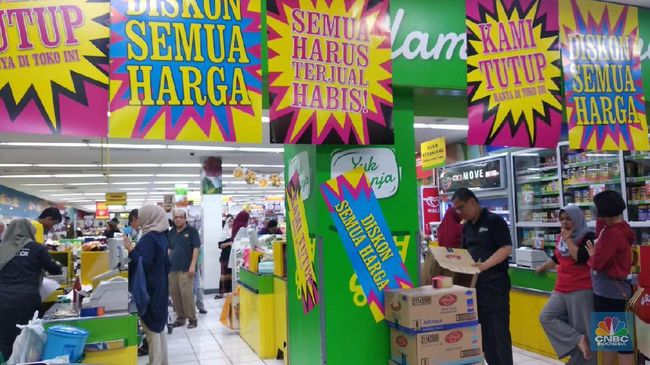Jakarta, CNBC Indonesia – Changes in shopping habits in the community (market dynamics) are considered to be one of the reasons for closing retail outlets in the country. The change in market dynamics has made the trend of monthly shopping to supermarkets decrease. Currently, people have a tendency to look for basic needs in more accessible places, around their homes, plus the proliferation of minimarkets.
This is one of the reasons for the Giant supermarket which is under the auspices of PT Hero Supermarket Tbk (HERO) will close all of its operations starting in July 2021.
In the disclosure of information on the Indonesia Stock Exchange (IDX), HERO Director Hardianus Wahyu Trikusumo said the decision to close Giant’s operations was a quick and precise response from the company needed to adapt to changing market dynamics.
Especially now that Indonesian consumers are using the hypermarket format in recent years, a phenomenon that also occurs in the global market. This condition could be an indication that people are starting to leave large format markets such as supermarkets. The effectiveness of shopping is one of the reasons.
Patrik Lindvall, President Director of HERO, in an explanation last April 30, emphasized that the financial performance of HERO’s grocery retail business continues to be significantly affected by the pandemic.
Strict social restrictions, domestic travel bans and in particular, the closing or imposition of strict restrictions on shopping centers/malls have changed customer spending patterns substantially and reduced the number of customer visits to these locations.
“As a result, this materially affects the performance of hypermarkets as large format shopping destinations which are the main tenants in shopping centers/malls and are where the majority of Giant’s store areas are located,” he said.
On a different occasion, the General Chairperson of the Indonesian Shopping Center Retailers and Tenants Association (Hippindo) Budihardjo Iduansjah also revealed the reasons behind the closing of retailers, including Giant.
“During the Covid-19 period, customers didn’t want to spend a long time shopping, the big format during the Covid-19 period decreased very, very drastically,” said Hippindo Chairman Budihardjo Iduansjah to CNBC Indonesia, quoted Sunday (30/5/21).
“But the small format, simple, search, buy and pay has been more developed, I think in the future it will become a kind of trend that people want something simple, don’t want it to be big or easy to park, don’t have to meet a lot of people to touch it. -touch and so on,” said Budihardjo.
In the case of Giant, these retail signs have been rocking even before the Covid-19 pandemic.
In July 2019, Giant closed 6 of its outlets citing the effect of changing people’s shopping styles. Hero had closed down Giant Margo, City Depok, West Java and Giant Kalibata, South Jakarta.
Until March 2021, there are only 75 outlets left for Giant outlets, for Giant Ekstra and Giant Ekspres. Throughout 2019 to March 2021, 25 Giant outlets were closed.
However, Budihardjo said that the large retail category still has its own market segment. Therefore, the hope for a growing hypermarket remains. However, hypermarkets don’t just wait for the ball or stand still.
“It will survive, in the context of having to innovate. For example, if it is not Covid-19, it must become a kind of destination, because it is big and complete. There will still be people who don’t want to go to small or incomplete retail, but still want to go complete big retail. So there are still certain segments that can be reached,” he said.
Offering these facilities is the main attraction for modern retail with big format. When visitors can get a lot of things in that place, hypermarkets can still be an option.
“It contains food, coffee, tea, mix-ups. So shopping while drinking and eating,” explained Budihardjo.
With capital providing experience, hypermarkets can survive. Therefore, the price war strategy like the one that existed so far is no longer the main choice going forward.
“It’s not a price war, but a service. Consumer to consumer is looking for a comfortable one. So there are still individual markets,” said Budihardjo.
NEXT: There are 7,000 employees laid off
– .

